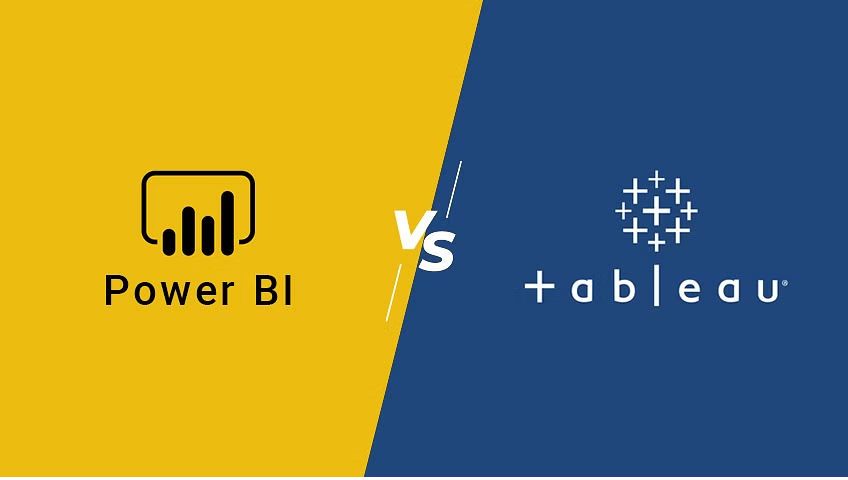Business intelligence (BI) tools have become an integral part of any organization.
Tableau and Power BI both are among the most popular BI platforms in the market.
Tableau is an excellent data visualization and BI tool used for reporting and analyzing large volumes of data.
Microsoft Power BI is an interactive data visualization software that primarily focus on BI.
If you are an analyst, CTO, or data scientist contemplating adapting the right BI tool, this article will help you make an informed decision.
What is Tableau?
Tableau is an interactive data visualization tool from Tableau Software, a data visualization company HQ in the USA. It was acquired by Salesforce in 2019.
Tableau helps organizations simplify data for easy analysis. It enables you to create compelling worksheets and dashboards.

Tableau has an active community of more than 220,000 users from the data science and data modeling world.
Tableau Features
- Vector Maps
- Nested Sorting
- Data Highlighter
- Workbook Formatting
- Custom Territories
- Data blending
- Data collaboration and data notifications
- Toggle view and drag-and-drop
- Dashboard commenting
Which Companies Use Tableau?
- Apple
- Lenovo
- Cisco Systems
- Box
- GoDaddy
- Seagate
- Wells Fargo
- JP Morgan Chase
- Verizon
- Honeywell
- Lufthansa
- Walmart
- Deloitte
- Nissan
Pros of Tableau
- Great performance
- A large number of visual objects
- Ability to blend diverse data sets
- Easy to learn and use
- Centralized data repository
- The active community of Tableau users
- Many official resources available for knowledge and training
Cons of Tableau
- Requires IT expertise for certain configurations
- High-Cost
What is Power BI?
Power BI is a business intelligence and data visualization tool by Microsoft. It was unveiled by Microsoft in 2013. After a couple of years of internal usage, Microsoft only made Power BI available to the public in 2015.
The Power BI tool allows users to create reports and dashboards through an intuitive interface. It helps non-technical users with tools in aggregating, analyzing, and presenting the data in a visual format.

Power BI can be easily integrated with other Microsoft products.
Power BI Features
- Easy collaboration and sharing of reports
- 360-degree view of data, natural-language query
- Navigation pane
- Ad Hoc reporting and analysis
- Online Analytical Processing (OLAP)
- Trend indicators
- Real-time dashboards
- Content Packs: for sharing dashboards with team.
Which Companies Use Power BI?
- Metro Bank
- Conde Nast
- Aston Martin
- Rolls Royce
- Heathrow
- Hewlett Packard
- Adobe
- Kraft Heinz
- GE Healthcare
- Rockwell Automation
Pros of Power BI
- Easy to use
- Constant updates with new features
- A number of data source connections
- Ability to create custom visualizations
- Active user community
Cons of Power BI
- Rigid formulas, it uses DAX as the language for calculations
- Free versions have data handling limitations
- Visualizations have limited configuration options
PowerBI vs Tableau

Key Difference between Power BI and Tableau
Power BI and Tableau are both powerful business intelligence tools that enable data visualization and analysis. While they have some similarities, there are key differences between the two:
- User Interface: Tableau has a more user-friendly and intuitive interface, with drag-and-drop functionality and easier-to-use visuals. Power BI can take a bit more time to learn but provides more robust functionality for advanced users.
- Data Integration: Power BI is more tightly integrated with Microsoft products, such as Excel and SQL Server, whereas Tableau can connect to a wider range of data sources, including cloud-based databases and web services.
- Pricing: Power BI offers a more affordable pricing structure, with a free version and lower-cost paid options. Tableau, on the other hand, can be more expensive, especially for enterprise-level solutions.
- Customization: Tableau provides more advanced customization options for dashboards and visualizations, whereas Power BI is more limited in this regard.
- Collaboration: Power BI has more collaboration features built-in, such as co-authoring and commenting, whereas Tableau requires third-party tools to achieve similar functionality.
- Ownership and Pricing: Power BI is a Microsoft product licensed on a per-user basis, while Tableau is owned by Salesforce and licensed on a per-user or per-server basis.
- Data Integration: Power BI is tightly integrated with other Microsoft products like Excel, Azure, and Dynamics 365, while Tableau has more options for integrating with third-party applications and data sources.
- Visualization Capabilities: Tableau is known for its exceptional visualization capabilities and has more advanced charting options. In contrast, Power BI has a more user-friendly interface for creating basic charts and visualizations.
- Data Modeling: Power BI has more robust data modeling and ETL (Extract, Transform, Load) capabilities than Tableau, making it a better choice for data manipulation and analysis.
- Collaboration: Tableau has more robust collaboration features, including creating and sharing interactive dashboards with other users, while Power BI is more focused on individual user analysis.
